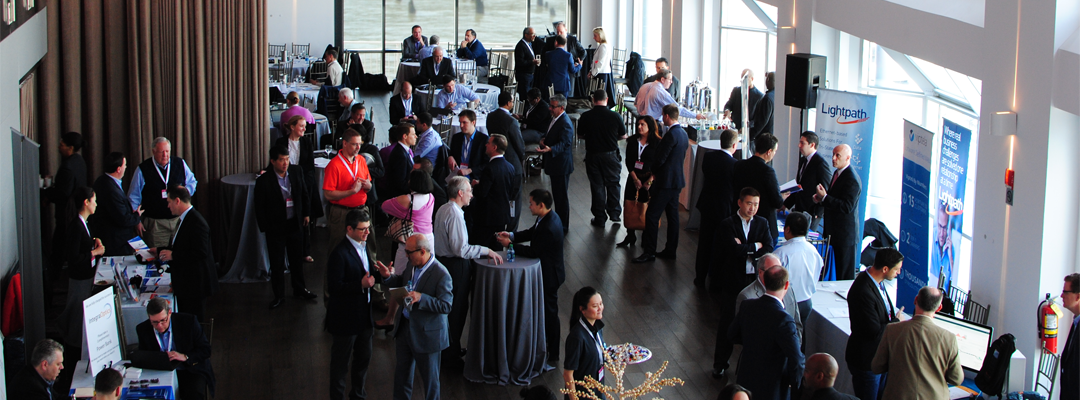How do you help hundreds of network managers, IT professionals, and service providers face some of their biggest technological challenges?
If you're Greg Bryan, you talk to them. You talk to them a lot. You gather case studies from companies and learn from vendors about the latest tools for wide area networking and cloud management.
And you chair the WAN Summit.
The WAN Summit is a conference series that TeleGeography kickstarted in 2013 to bring together network managers, service providers, and vendors to keep up with the latest trends in technology and share ideas about all things networking. As WAN Summit Chair, Greg helps assemble the programming for each event, meticulously tracking trends in wide area networking, learning from the expertise of summit sponsors, and tapping leading voices to lend their knowledge to the conference.
As WAN Summit New York creeps closer, Greg took the time to talk to us about how he prepares for a WAN Summit and what it takes to develop an agenda that addresses what's actually happening in the networking world. Read the full interview below or listen here.
Jayne Miller: Thanks for taking the time to talk through some of the information about the WAN Summit today, Greg.
Greg Bryan: Thank you, Jayne. It’s absolutely my pleasure.
JM: So, as many of our readers know—and for those who don’t—the WAN Summit is not something that is new. And this is not your first rodeo. We’ve been through these programs in Singapore, New York, and London before.
What can we expect at WAN Summit New York that is coming up next month in April? How will it compare to the programs we’ve seen in 2015, 2016?
GB: Absolutely. I’ve been to every single WAN Summit that there’s ever been. Since the beginning, since we started this in London in the fall of 2013, we’ve always talked about these kinds of challenges that WAN managers face in provisioning a network, sourcing it in the best way.
But those challenges have changed over time as new technology has come up. We’ve talked pretty much at all of these WAN Summits about connecting to the cloud, meeting bandwidth demands on a budget, maximizing the WAN you have with the various tools available. But over time that conversation has morphed with the way the industry has morphed, so for the last couple of years, obviously SD-WAN has been the really big topic that everybody wants to talk about.
What I think is interesting and unique about this New York event is that we now have come to the point where we have collected some real case studies that go through that process from start to finish.
So, whereas at past events we’re talking about maybe the justifications for SD-WAN or the process of selecting SD-WAN providers, but this time we’re actually going to be able to have a few folks onstage who’ve done it. They’re completed with the project and can say: “This is how it went. This is how I might wish it could have gone,” and those kinds of things. I think that’s going to be really interesting.
The other new thing that I think we’re going to talk much more about this time—we’ve always talked, like I said, about connecting to the cloud—but now we’re going to look specifically at the data center itself. And how the data center has been moving from maybe some corporate facilities into shared spaces, and why they’ve done that. Why you might consider doing that, if you haven’t. And kind of what that does for the WAN manager, in addition to the IT team.
Finally, a theme that we’ve had, again, in parts of past WAN Summits—but new things keep coming up with this—just looking at how the WAN is changing going forward.
For a long time we’ve been talking about things like BYOD. We’ve been talking about remote workers. But we have a panel now that’s focused entirely on the changing nature of the workplace and how that affects the job of the WAN manager.
One of the key things we’re hitting in that panel is going to be the internet of things, which, again, has been on the horizon. It’s not like people haven’t seen that coming, but for a lot of enterprises really it's now becoming a reality that they have to deal with. So we’re gonna have a few folks who’ve had some experience in dealing with that, and hopefully be able to share those experiences.
JM: Not to oversimplify your answer, but in this industry you’d say that things change. They don’t stay the same for very long, so the WAN Summit is keeping pace with the rest of the world and WAN managers across the globe.
GB: I wish I could be that succinct.
JM: Another thing we always look forward to leading up to these events is not just the new content of the panels and the case studies, but the actual speakers.
We get new folks coming through WAN Summits every year. Are there any new speakers in the lineup—not just for New York—but any of the 2017 summits that you’re maybe extra excited about?
GB: One of the great strengths of the WAN Summit is that we try really hard every conference to put as many end-user voices on stage as possible.
So in London we had Snehal Patel from The Gap present on their transition to SD-WAN. He’s going to do an update of that presentation here for the New York audience, so it will be new to them.
We’ve also, in addition to some enterprise end-users that we’ve had onstage before, we have a lot of new end-user participants. What I think is great here is that it really expands the industries that we’re hearing from, right?
So, I think it’s really key that there may be someone in retail like Gap Inc. that has a different industry, different set of challenges—but some of their challenges and how they met them are still useful for you in whatever industry you’re in.
Like I said, I think the key is sort of hitting a broad range of industries, so that whatever industry you’re from, you might be able to pick out some useful little tidbits from all of those different places and apply them to your situation.
JM: You’ve touched on this a little bit in your first answer—what we could expect that’s different in 2017—and that is that people are coming to the WAN Summit from many different perspectives. Oftentimes folks are solving a problem. What sort of problems are attendees trying to solve and how do you build a program that helps them do that?
GB: Yeah, that’s a great question, so I mean this is one of the key things that I’m constantly working on in my role as the WAN Summit Chair, really, is trying to understand what those problems are. This is exactly why we have an advisory board, again, that spans several different industries so that we can get a feel from that advisory board. And not only do they run through the agenda, but I talk to them, they talk to each other—so we can all exchange ideas in this respect.
This is the kind of thing I think about all the time. And I should just say, if you see me at the conference, I’d love to talk to you about this.
Really, the challenge of the WAN manager is that the network itself, what’s available, is always changing. But also, your situation is always changing. Your IT department is now asking you to allow BYOD. Or you IT Department is now saying, “hey, we have all of these new IoT devices that we want to bring online.”
These things that other folks within your company—whether it’s the IT department, or the finance department—come to you, as your problem. And those are the types of things we’re hoping to give perspective on at the WAN Summit, again from the vendor side—what tools they have to help with those kind of things. But also from your peers onstage. “This is what my IT department came to me with,” or whatever the case may be.
I think the key there is that whatever strategy you had three years ago, when it comes time for renewal or whatever the case may be, is probably not the strategy you’re going to have this time. And it’s probably not the strategy you’re going to have three years from now.
And it might really behoove you to start thinking, “well how is my strategy going to look different three years from now? So I’m not just solving my immediate network problems, but what can I see that’s coming down the pike.”
That’s the real impetus behind some of panels like “The Future of Your WAN.” We try and help you sort of model things and stay on top of those issues before they become problems. They’re just issues. Issues sounds friendlier.
JM: On that note, one final question, about you. You are more or less our WAN Summit MC here. You’ve been to every event. You know the ropes. How do you prepare? How will you be getting ready for WAN Summit New York this year?
GB: For me it’s a long couple of days, so cardio, weights, you know. [Laughs]
The main thing for me is to, just like everything we’ve been saying, have fresh in my mind what kind of concerns and issues are most important for folks in attendance so I can converse with them at breaks, at roundtables—that sort of thing. And what I’m thinking in many cases [is also about] what I can put on the next WAN Summit agenda or this one next year. How do I make that even more relevant for this group of people?
That’s how I prepare. I think I’ve been preparing in the setup for the whole event, which is talking to these people. Again, whether it’s for our sponsors or other vendors or the WAN managers themselves.
JM: We’ll be listening because so many good ideas come out of these conferences every year and we shamelessly steal them for our blog. As we learn more about the latest in SD-WAN and what is happening with all of those IoT devices coming online—we’ll also be sharing that with our readers.
Thanks for giving us a glimpse into the inner workings of the WAN Summit and what we can expect.
GB: My pleasure, thank you.
Greg Bryan
Greg is Senior Manager, Enterprise Research at TeleGeography. He's spent the last decade and a half at TeleGeography developing many of our pricing products and reports about enterprise networks. He is a frequent speaker at conferences about corporate wide area networks and enterprise telecom services. He also hosts our podcast, TeleGeography Explains the Internet.


